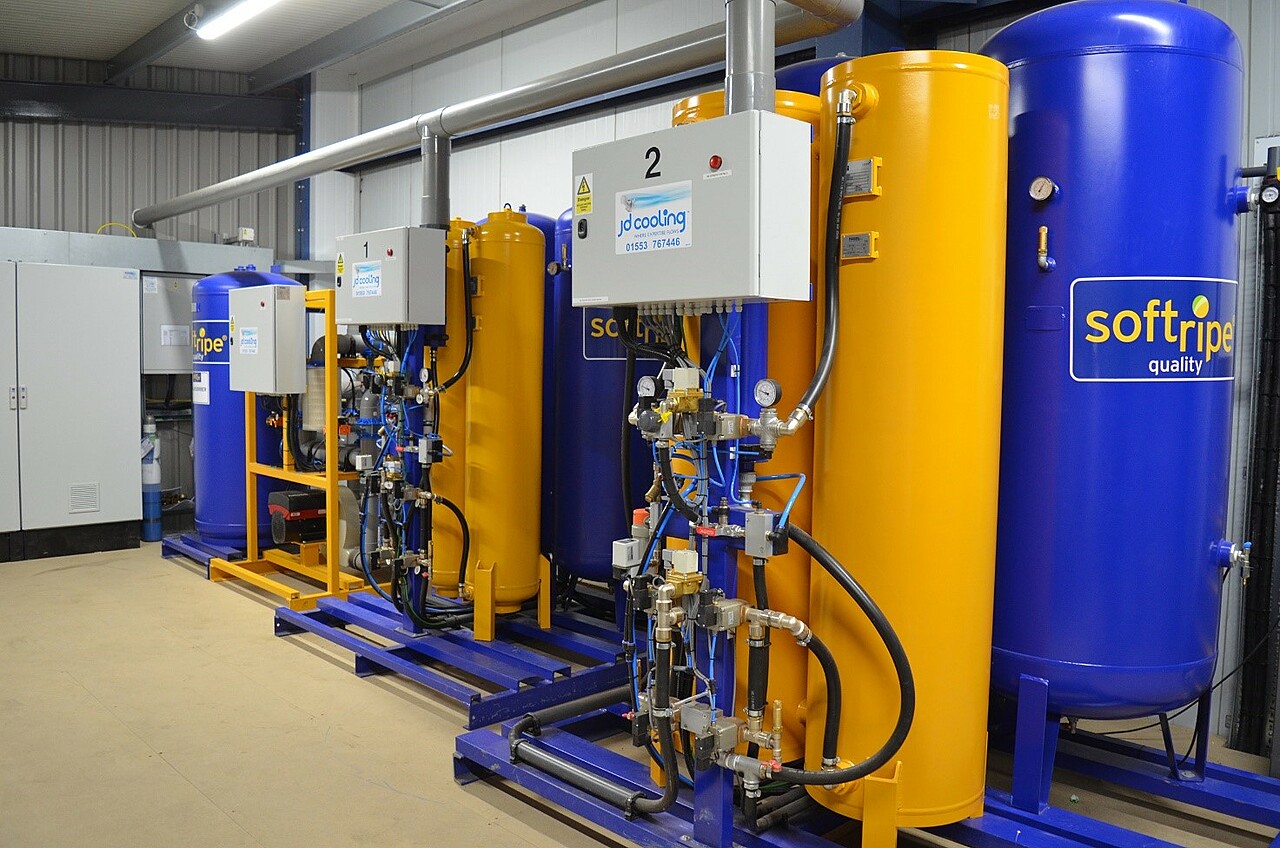Refrigeration innovations for the avocado market
The booming global avocado market calls for increasing standards of quality. Refrigeration technologies offer cutting-edge solutions for fruit ripening and seed preservation for future crops.
The global avocado market has been valued at 13.64 billion of US dollars and is expected to continue to grow steadily by 5.9% annually. With such a strong market and new suppliers emerging from different countries, it is crucial for the industry to focus on quality and higher standards for fruit ripening. [1]
Avocado ripening [2, 3]
The avocado ripening process is the result of several chemical reactions influenced by various factors such as temperature, levels of ethene (or ethylene) and carbon dioxide (CO2). These factors can be controlled in a ripening room. Most ripening rooms include the following components:
- A cooler to cool the ripening room (e.g. a direct expansion evaporator, or a cold-water coil)
- Electric heating elements to heat up the ripening room, or a hot water circuit
- An ethene generator, or ethene injection
- Ventilation to supply fresh air containing oxygen and to remove excess CO2
- A humidifier to maintain high humidity levels and prevent the fruit from drying out
- A system to efficiently guide the air flow through the pallets, to control the temperature of the fruit and the concentration of the above-mentioned molecules
- Sensors to measure temperature, humidity, CO2, ethene and oxygen
Ethene is an odourless, colourless gas that is produced and released by most fresh fruits and vegetables as a natural ripening agent. In a ripening room, the combination of warm air and the release of ethylene into the room triggers the start of the ripening process. Ventilation (i.e. maintaining the concentration of oxygen) keeps the reaction going. Later, a high concentration of CO2 or a low concentration of oxygen can be used to slow down the ripening process. Additionally, avocado ripening is a thermodynamic challenge because of the almost spherical shape of the avocado which affects the control of the temperature from the avocado skin to its core during ripening.

In the UK, JD Cooling Group, an independent supplier of temperature control systems, and Worldwide Fruit Ltd have unveiled their new “Softripe” avocado ripening facility. Softripe is a patented technology that uses a fully gas-tight chamber along with CO2 absorbers and nitrogen generators to allow control of optimum levels of ethylene, CO2 and oxygen. JD Cooling reports that compared to other ripening technologies, Softripe uses lower temperatures and higher humidity levels. Furthermore, Softripe’s software algorithms establish optimum conditions, adapting to the needs of the fruits throughout the ripening process. This should lead to a more uniform fruit ripening process, thus limiting waste. 132 pallets using Softripe technology are now in service and “Softripe” avocados are expected to be available in stores in the UK in October 2020.
Cryopreservation of avocado shoots [4 – 7]
Conservation of seeds is essential to preserve genetic diversity as well as plants that are resistant to drought or diseases for future crops. For short-term storage, seeds are dried and placed in sealed containers at 5°C. [4] For long-term storage, the seeds are frozen at ultra-low temperatures.
Cryopreservation involves storage of plant material (such as seed, shoot tip, embryos and pollen) at ultra-low temperatures in liquid nitrogen (-196°C) or its vapor phase (-150°C). At ultra-low temperatures, cell division, metabolic, and biochemical activities remain suspended and plant material can potentially be stored without changes and deterioration for extended periods of time. [5] Cryopreservation has been used to preserve dozens of genetic lines of plants such as bananas, potatoes and apples.
Unfortunately, avocado seeds are considered “recalcitrant seeds”. They have a short shelf life, do not tolerate dehydration and are therefore difficult to store in any form other than on trees in the field.
For the first time, scientists at the University of Queensland in Australia have achieved a breakthrough: freezing the tips of avocado shoots in liquid nitrogen, then successfully reviving them. For cryopreservation, the avocado shoot tips are placed on an aluminium foil strip for rapid cooling and rewarming, and then placed into a “cryotube” before being stored in liquid nitrogen. Later, the frozen shoot tips can be revived in a petri dish containing a sucrose mixture to rehydrate them. [7]
Associated with a novel technology allowing for the propagation of multiple plants from tissue culture, up to 500 plants have been propagated from one avocado shoot tip and 80 are now growing in the university's glass house.
Many of the genetically valuable avocado trees are currently located in areas threatened by wildfires, diseases or located in developing countries where up to 40% of the forest cover has already been lost. [6] This scientific breakthrough in cryopreservation would allow to preserve avocado genetic material which is valuable for the industry.
Sources:
[1] https://www.inspirafarms.com/avocado-market-trends-hitting-2020/
[2] C.B. Maat and N. Holswilder. Interko. July 2020. Avocado ripening technology. https://issuu.com/horticulturaposcosecha/docs/avocado_ripening_technology
[3] https://www.jdcooling.com/game-changing-softripe-avocado-facility-unveiled/
[4] http://sbc.ucdavis.edu/About_US/Seed_Biotechnologies/Seed_Storage_Conservation/
[5] Radha, R. K., Decruse, W. S., & Krishnan, P. N. (2012). Plant cryopreservation. In Current Frontiers in Cryopreservation. IntechOpen. https://www.intechopen.com/books/current-frontiers-in-cryopreservation/plant-cryopreservation-
[6] https://www.abc.net.au/news/rural/2020-09-10/avocados-preservation-science-cryopreservation/12643822
[7] https://www.uq.edu.au/news/article/2020/09/putting-future-avocado-apocalypse-ice
